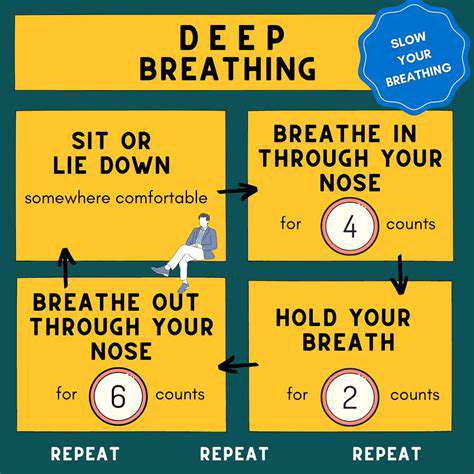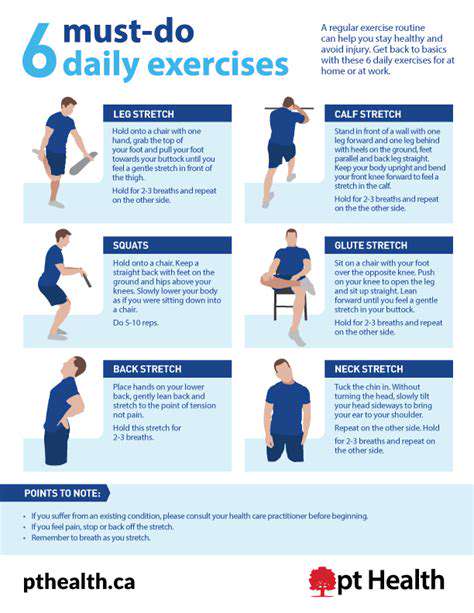Exercise with a Walker: Strength and Balance for Older Adults
Getting Started with Walking Exercises
Choosing the Right Walker
Selecting a suitable walker is crucial for a safe and effective walking exercise program. Consider factors like the walker's weight capacity, adjustable features (height and width), and overall stability. A walker that's too small or unstable can hinder your progress and increase the risk of falls. Make sure the walker feels comfortable and supportive when you try it out. Proper fit is paramount to maximizing your workout and ensuring a smooth, safe experience throughout your exercises.
Look for features like padded armrests for added comfort during longer sessions. A sturdy frame and reliable brakes are also essential for safety. Consult with your doctor or a physical therapist to determine the best walker type for your individual needs and physical condition. They can help you choose a walker that aligns with your specific goals and limitations.
Warm-up Exercises Before Walking
Preparing your body for walking with a walker involves a series of gentle warm-up exercises to increase blood flow and prepare muscles for activity. These exercises should be tailored to your fitness level and any existing health concerns. Start with simple arm circles, shoulder rotations, and wrist stretches to loosen up your joints. Gentle leg swings and heel-toe raises can also help prepare your lower body for the walking exercise.
Remember to maintain a controlled pace and avoid any sudden movements. Each exercise should be performed for about 10-15 repetitions. Pay close attention to any pain or discomfort. If you experience any, stop the exercise and consult your doctor. These warm-up exercises are crucial for preventing injuries during your walking routine with a walker.
Basic Walking Techniques with a Walker
Maintaining proper posture and balance is key to safe and effective walking with a walker. Keep your back straight, shoulders relaxed, and head held high. When moving, push off with your legs, using the walker for support. Ensure your steps are steady and controlled. Focus on maintaining a consistent pace, rather than rushing through the exercise.
Practice taking small, controlled steps while using the walker for balance. Ensure your steps are coordinated and your body weight is evenly distributed. If you feel unsteady, adjust your posture or take a rest. Consistency is key for building strength and endurance. By focusing on these techniques, you'll develop the ability to walk with a walker safely and effectively.
Building Strength and Endurance
Gradually increasing the duration and intensity of your walking sessions with a walker is vital for building strength and endurance. Start with shorter sessions and gradually increase the time as you get stronger. Consider incorporating hills or inclines into your route to challenge your muscles and improve cardiovascular fitness. As your strength improves, you can also increase your pace and step length.
Focus on maintaining a regular walking schedule. Consistency is key to achieving your fitness goals. To further enhance your strength training, consider incorporating resistance exercises or weight training into your routine, but always consult with a physical therapist or your doctor to create a suitable plan. This gradual progression will enable you to build strength and endurance safely and effectively.
Safety Precautions and Considerations
Prioritizing safety is paramount when walking with a walker. Always wear appropriate footwear for support and traction. Ensure your walking path is clear of obstacles and well-lit. Be mindful of your surroundings and other pedestrians to avoid collisions. Consider using a walking cane or other assistive devices if needed for additional support.
If you experience any pain, dizziness, or discomfort during your walk, stop immediately and seek medical attention. Always be aware of your limits and don't push yourself beyond your capabilities. Regular check-ups with your doctor are vital to monitor your progress and address any potential issues.
Strengthening Exercises with a Walker

Walking as a Strength-Building Activity
Walking, often perceived as a low-impact exercise, can actually be a powerful tool for building strength, particularly in the legs and core. The repetitive motion engages numerous muscle groups, promoting strength gains over time. Walking uphill or incorporating intervals of faster pacing further amplifies this effect, challenging the muscles to work harder and increasing the intensity of the workout.
Benefits of Incorporating Walking into Your Routine
Incorporating walking into your daily routine offers a multitude of benefits beyond just physical strength. Walking has been shown to improve cardiovascular health, boost mood, and reduce stress levels. The rhythmic motion and fresh air exposure can provide a meditative experience, promoting relaxation and mental clarity.
Choosing the Right Walking Terrain
The terrain you choose for your walks significantly impacts the intensity of your workout. Walking on an incline, whether it's a hill or a treadmill with an incline setting, provides a greater challenge to your leg muscles, leading to a more significant strength-building effect. Uneven terrain, such as trails with varied elevation changes, can also enhance the workout and engage more muscles for balance and stability.
Varying Your Pace and Intensity
Adding variety to your walking pace and intensity is key to maximizing strength gains. Incorporating intervals of brisk walking or jogging can significantly increase the intensity of your workout, challenging your muscles in different ways. Gradually increasing the duration and intensity of your walks over time will lead to progressive muscle strength development.
Essential Considerations for Safety
While walking is generally safe, certain precautions are essential to avoid injuries. Wearing appropriate footwear that provides adequate support and cushioning is crucial for protecting your joints. Staying hydrated by drinking plenty of water before, during, and after your walks is also important to maintain optimal physical function. Consider the weather conditions and adjust your walking time and pace accordingly.
Using Walking as a Warm-up or Cool-down
Walking can be an excellent warm-up for more intense workouts, preparing your muscles for the activity ahead. It also serves as an effective cool-down, gradually decreasing your heart rate and allowing your body to recover. This gradual transition can help prevent muscle soreness and stiffness.
Combining Walking with Other Exercises
Walking can be a fantastic complement to other strength training exercises. It can be a great way to build endurance and cardiovascular fitness. Incorporating walking into your routine can help in achieving a well-rounded fitness program. By combining walking with other exercises such as weightlifting or yoga, you can achieve a comprehensive approach to overall fitness and strength development.
Improving Balance and Coordination with a Walker
Benefits of Using a Walker for Balance
Walking aids, such as walkers, provide significant support and stability, which is crucial for improving balance and coordination. By reducing the strain on your joints and providing a wider base of support, walkers allow you to take more confident and controlled steps. This increased stability translates directly into a reduced risk of falls, a common concern for individuals with balance issues. Consistent use of a walker can help build confidence and improve your overall mobility, enabling you to engage in daily activities with greater ease and independence.
Furthermore, the controlled movement pattern encouraged by using a walker can help strengthen the muscles responsible for balance and coordination. Regular practice with the walker can lead to a noticeable improvement in your ability to maintain equilibrium, both while standing and while walking. This is particularly beneficial for those recovering from injuries or undergoing rehabilitation.
Strengthening Muscles with Walker Exercises
Using a walker isn't just about maintaining balance; it's also an excellent tool for strengthening muscles throughout your body. Simple exercises like controlled stepping and short walks with the walker can engage muscles in your legs, core, and even your upper body. These exercises can help to rebuild muscle strength, which is essential for maintaining mobility and preventing further deterioration of physical function.
Incorporating resistance exercises using the walker, such as pushing or pulling light weights while using the walker, can be highly effective for strengthening specific muscle groups. This gradual increase in resistance can help to build strength progressively and safely. Consistent exercise with a walker can help to improve overall muscular endurance, enabling you to perform everyday tasks with greater ease.
Walker-Assisted Activities of Daily Living
A walker can be a valuable asset in performing everyday tasks, such as grocery shopping, household chores, and attending social events. With the increased stability and support that walkers provide, individuals can navigate various environments with greater confidence. This increased independence allows for greater participation in social and community activities, combating feelings of isolation and promoting a more active lifestyle.
The walker's ability to make these activities easier also reduces the risk of falls and injuries. By making everyday tasks achievable, walkers help maintain a higher quality of life, enabling individuals to remain active and engaged members of their communities.
Choosing the Right Walker for Your Needs
Selecting the appropriate walker is crucial for maximizing its benefits. Consider factors such as the walker's height, weight capacity, and the specific needs of your body. Different types of walkers are designed to accommodate varying levels of mobility and support. Talking to a physical therapist or occupational therapist can provide valuable insights into choosing a walker that best suits your individual needs and ensures proper fit.
This personalized approach to selecting a walker ensures optimal support and comfort, reducing the risk of discomfort or injury during use. A correctly fitted walker will contribute to greater user satisfaction and encourage consistent use, leading to improved balance and coordination. This personalized assessment is a key step in creating a safe and effective exercise routine.
Safety Precautions and Proper Use
Safety is paramount when using a walker. Always ensure the walker is in good working order and that all components are secure before use. Pay close attention to the surroundings and be aware of any potential hazards or obstacles that could lead to falls. Using a walker doesn't eliminate the need for caution, and maintaining awareness of your environment is essential.
Proper technique is also critical for safe and effective use. Learn the correct posture and stance while using the walker, and avoid rushing or making sudden movements. Following these precautions and guidelines can significantly reduce the risk of falls and injuries and maximize the benefits of using a walker for improving balance and coordination.












